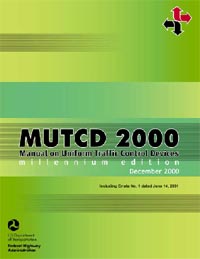Millennium Edition
With incorporated
Revision No. 1 changes, dated December 28, 2001

Viewing the
MUTCD
If you have difficulty viewing the MUTCD sections below (in PDF
format), you may need to download and install new software. For
best results we recommend Netscape
Navigator, version 4 or higher, Internet
Explorer, version 4 or higher, and Adobe
Reader.
Certain Chapters of the MUTCD (those affected by Revision No. 1 changes) may be viewed in HTML format,
in addition to PDF format. HTML formatted chapters are accessible to individuals with disabilities.
Printing the MUTCD
The new manual is set up for double-sided, offset printing of over
1100 sheets of paper to be placed in a three-ring binder. The first
5 pages include a spine, title page, cover page, etc. If you are
having trouble printing the MUTCD, you may need to adjust settings
in "File > Page Setup" menu, in Adobe Acrobat. A high-grade
ink-jet or laser printer is recommended for a quality hard copy.
Certain chapters and sections of the MUTCD have very large file
sizes due to the large page count, number of illustrations, or both,
contained within (example, Section 6H, 96 pages with 46 illustrations).
These large files can present problems when printing, depending on the
printer used. This is often due to the amount of memory within the
printer itself, which is often minimal, especially with the printers
sold through office supply outlets. If the printer will not print the
file, or prints it with errors, sending the file to the printer in
smaller sections (10-20 pages at a time) often solves the problem.
To
extract images from the MUTCD, click here.
For Editorial Changes, click here.
For Revision No. 1 Changes, click here.
 COVER
AND INTRODUCTION (PDF format) COVER
AND INTRODUCTION (PDF format)
COVER
AND INTRODUCTION (HTML format)
 TABLE
OF CONTENTS TABLE
OF CONTENTS
 PART
1 — GENERAL PROVISIONS (PDF Format) PART
1 — GENERAL PROVISIONS (PDF Format)
PART
1 — GENERAL PROVISIONS (HTML format)
PART
2 — SIGNS
 Chapter
2A — General Provisions and Standards Chapter
2A — General Provisions and Standards
 Chapter
2B — Regulatory Signs Chapter
2B — Regulatory Signs
 Chapter
2C — Warning Signs Chapter
2C — Warning Signs
 Chapter
2D — Conventional Signs Chapter
2D — Conventional Signs
 Chapter
2E — Freeways and Expressways Chapter
2E — Freeways and Expressways
 Chapters
2F - 2I Chapters
2F - 2I
Chapter
2F — Specific Service Signs
Chapter 2G — Tourist-Oriented Directional Signs (TODS)
Chapter 2H — Recreational and Cultural Interest Area Signs
Chapter 2I — Emergency Management Signing
 PART
3 — MARKINGS PART
3 — MARKINGS
PART
4 — HIGHWAY TRAFFIC SIGNALS
 Chapter 4A - 4D
(PDF Format)
Chapter 4A - 4D
(PDF Format)
Chapter
4A - 4D (HTML format)
Chapter
4A — General
Chapter 4B — Traffic Control Signals, General
Chapter 4C — Traffic
Control Signal Needs Studies
Chapter 4D — Traffic
Control Signal Features
 Chapter
4E - 4L (PDF Format) Chapter
4E - 4L (PDF Format)
Chapter
4E - 4L (HTML format)
Chapter
4E — Pedestrian Control Features
Chapter 4F — Traffic Control Signals for Emergency Vehicle
Access
Chapter 4G — Traffic
Control Signals for One-Lane, Two-Way Facilities
Chapter 4H — Traffic
Control Signals for Freeway Entrance Ramps
Chapter
4I — Traffic
Control for Movable Bridges
Chapter
4J — Lane-Use Control Signals
Chapter
4K — Flashing Beacons
Chapter
4L— In-Roadway Lights
 PART
5 — LOW-VOLUME RURAL ROADS PART
5 — LOW-VOLUME RURAL ROADS
PART
6 — TEMPORARY TRAFFIC CONTROL
 Chapter
6A — Introduction Chapter
6A — Introduction
 Chapter
6B — Fundamental Principles Chapter
6B — Fundamental Principles
 Chapter
6C — Temporary Traffic Control Elements Chapter
6C — Temporary Traffic Control Elements
 Chapter
6D — Pedestrian and Worker Safety Chapter
6D — Pedestrian and Worker Safety
 Chapter
6E — Flagger Control Chapter
6E — Flagger Control
 Chapter
6F — Temporary Traffic Control Zone Devices Chapter
6F — Temporary Traffic Control Zone Devices
 Chapter
6G — Type of Temporary Traffic Control Zone Activities Chapter
6G — Type of Temporary Traffic Control Zone Activities
 Chapter
6H — Application of Devices Chapter
6H — Application of Devices
 PART
7 — TRAFFIC CONTROLS FOR SCHOOL AREAS PART
7 — TRAFFIC CONTROLS FOR SCHOOL AREAS
 PART
8 — TRAFFIC CONTROLS FOR HIGHWAY-RAIL GRADE CROSSINGS PART
8 — TRAFFIC CONTROLS FOR HIGHWAY-RAIL GRADE CROSSINGS
 PART
9 — TRAFFIC CONTROLS FOR BICYCLE FACILITIES PART
9 — TRAFFIC CONTROLS FOR BICYCLE FACILITIES
 PART
10 — TRAFFIC CONTROLS FOR HIGHWAY-LIGHT RAIL TRANSIT GRADE CROSSINGS PART
10 — TRAFFIC CONTROLS FOR HIGHWAY-LIGHT RAIL TRANSIT GRADE CROSSINGS
 APPENDIX A1 APPENDIX A1 |


